Passap Tuckerboard Tuck Stitch Reversible Baby Blanket Afghan Pattern
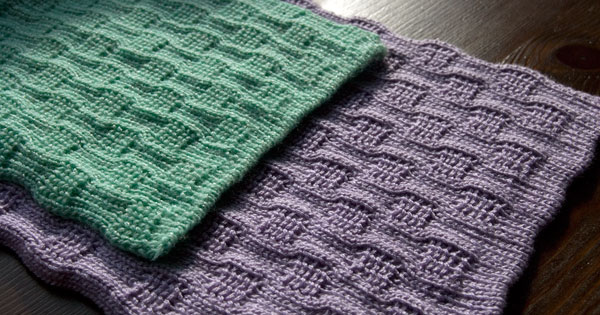
The opportunities to create reversible textured fabric with a Passap are endless. These samples use the FX lock setting, hand selected pushers, and no pattern card. When pushers are up in working position, the machine knits normally. When pushers are down in rest position, the machine knits fishermans rib. The finished fabric is beautifully patterned on both sides.
Step 1 – Bring Up Needles For Cast On
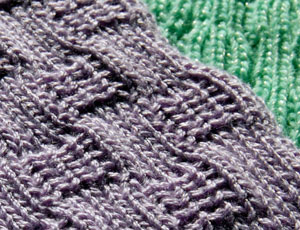 I wanted a symmetrical look to my samples, so I used 47 needles on the front bed and 46 needles on the back. This allows for 5 and a half horizontal pattern repeats plus one stitch on each front edge to insure the tucked stitches don’t fall off.
I wanted a symmetrical look to my samples, so I used 47 needles on the front bed and 46 needles on the back. This allows for 5 and a half horizontal pattern repeats plus one stitch on each front edge to insure the tucked stitches don’t fall off.
It also means the vertical scalloped edge is not staggered since both sides of the mini blanket will end with either a plain square (edge scallops in) or a fishermans tuck square (edge scallops out)
Step 2 – Tubular Cast On
|
As mentioned in step 1, I had 47 needles on the front bed and 46 on the back, which means both of my end needles were on the front, disregarding the Passap needle rule. Nothing bad happened to me. |
|
|
|
If you prefer to follow the Passap needle rule where the right most needle is on the back bed, cast on 46 stitches on both beds per the diagram. When finished, bring up an extra front bed needle on the right and place a purl bump on it before doing step 3. |
|
The lavendar yarn, a cotton acrylic blend, was thicker than the green, a vintage thin baby fingerling wool. Both were unlabeled leftovers languishing in my stash. Depending on the thickness of your yarn, you may need to adjust the cast on tension settings. Here were mine:
|
Lavender Cotton Blend Sample
|
Green Fingerling Wool Sample |
Step 3 – Bottom Border Rows
With cast on complete, knit 4 more rows in full needle rib (N/N setting all needles knit) ending with lock at the right. This ends the bottom border of the swatch.
For the lavender swatch, I slowly increased the tension from 5, 5.25, 5.5, to 6.0 with each of these passes so at the end of the fourth N/N row I was at 6.0, my patterning tension. For the green sample, I kept it at 4.5 throughout.
Step 4 – Arrange Pattern Needles and Pushers
|
When bottom border is finished, rearrange needles and pushers per the following diagram. |
| |
|
RC000 |
|
Remember, manually lower the left and right most pusher at the beginning of the first <-FX row for each pattern repeat. ie before knitting row 1 of pattern, manually lower the left most and right most pusher on the front bed. Knit through row 10 of pattern. Before knitting row 11, repeat process, lowering the left most and right most pusher on the front bed. Continue doing this at the beginning of each 10 row pattern repeat.
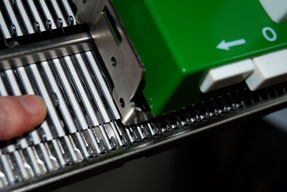

Why? You want the edge stitches to always knit, never tuck. Since the front lock is on FX for the entire blanket, and the pushers change position once every 10 rows, you have to manually put these two pushers down or you will end up tucking the edge stitches and dropping them. It also gives a very neat edge that gently rolls to the back and mirrors the look of the back patterning. A win win and easy edge.
Step 5 – Top Border Rows
STOP! – Pull up purl bumps to fill in for full needle rib on the front bed.
Lock on right
N/N Knit 3 rows ending lock on left
Step 6 – Tubular Cast Off
STOP! – transfer front right stitch to back right needle so there are an even number of stitches on the front and back beds with the last stitch on the right on the back bed.
|
Lavender Cotton Blend Sample
|
Green Fingerling Wool Sample |
Step 7 – Half Tubular Waste Knitting
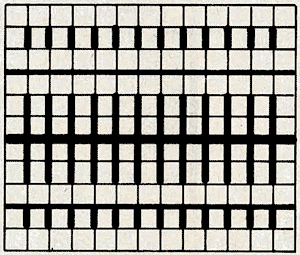 Switch to waste yarn
Switch to waste yarn
Lock BX->/BX->
Black strippers
Racking handle up
Arrange the needles and pushers per the diagram.
On the front bed, the pushers are up in working position. On the back bed, the pushers are down in rest position.
Knit at least 6 rounds and then remove.
Step 8 – Weave End Stitches
For a true tubular cast off, weave (kitchener) the front and back stitches together by pulling out a length of main yarn at least three times the width of the finished blanket and starting at the end where the main yarn tail is attached.
When done, measure your swatch to determine how many stitches wide and how many rows long you will need for your baby blanket.
References
Passap Model Book pattern 7032 – baby rug with same pattern, but no border or extra edge stitches
Passap Duomatic 80 Manual
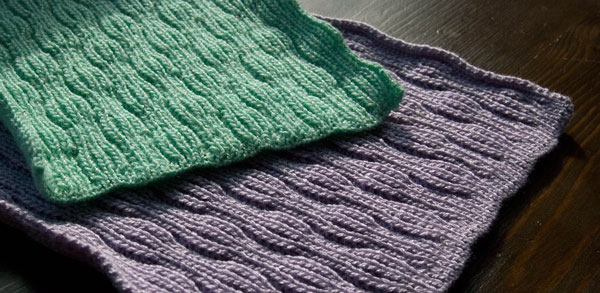
Related Posts
February 21, 2008

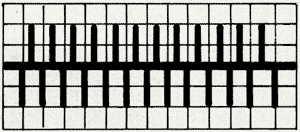
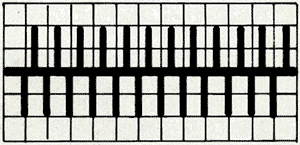
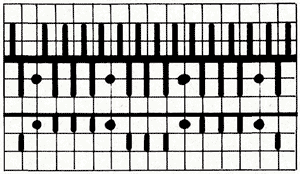
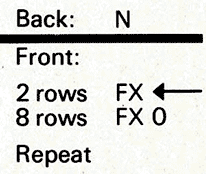







16 comments
Just found your Web site this morning and am so happy I just want to get started kniting this baby blanket as soon as I find out how to install the racking handle and how to put the deco on to the front bed. Any help you can give will be greatly appreciated. Thank in advance. Elaine
I have recently purchased a Passap Duomatic 80 manual (Green) and am still trying to learn to use it. I have come across your site on several Google searchs and would like to try and make the tuckerboard baby blanket but aqm still confused on how to use the pushers on the machine (I don’t have the original owners manual). Would it be too much to ask for some guidance on exactly where the pushers should be positiond? I’m just not sure what the correct positions are.
When they are out of the locking rail and resting down against the top of the locking rail is this at rest?
When they are out of the locking rail and about half way up to the top rail is that working position?
Your diagram seems to show some up at the very top, some in the middle, and some out of the locking rail but down at the very bottom.
I’ll try and figure out what a “purl bump” is later.
I’m insprired by your work but still trying to learn some of the basics of the machine.
-Kevin
Kevin,
You really need to find the Duo 80 manual. I’ve seen them on eBay at very reasonable prices. The book is spiral bound. A picture of it can be seen here:
https://www.knittsings.com/the-passap-duo-80/
Another good source of free beginner information on the Passap and how the pushers work can be found in the yahoo group, PassapClub. It has a wonderful tutorial resource in its files area that takes you step by step through Passap basics.
Here is a super quickie overview:
When pushers are locked in the blocking rail, they are considered out of work and will have no impact on the knitting regardless of the lock setting (ie AX, BX, DX, etc) or arrow key.
When pushers are out the the rail, but resting on the rail, they are said to be in rest position, awaiting to be picked up by the lock if an appropriate lock setting is picked and/or if an arrow key is pushed in.
Pushers half way up are in work position, and will affect the knitting if an appropriate lock setting is picked and/or if an arrow key is pushed in.
Keep in mind some lock settings ignore the pushers regardless of their position.
If you look closely at your needle bed, you will find that it is etched about 5/8 inch above the blocker rail. Pushers in working position line up with that mark. There is similar etching on the upper part of the needle bed. The other end of the pushers line up with that mark. But you don’t have to know exactly where to put the pushers. Just move them out of the blocking rail, press down an arrow button and run the lock slowly back and forth. You’ll see how the pushers move up and down, alternating between being in and out of work.
good resourse Anyway by sight very much it is pleasant to me
I found your web site while looking for the manual to my Passap Ribber attachment. While I didn’t find the actual one, I took your advice and downloaded one that looks similar. I look forward to play around your site again, it is very nice! Thanks.
I have a E6000 but have only done basic knitting. Does the above instructions apply to this machine
just got my duo 80 passap with motor, put it together but can’t get the connector rod for the lock to go down so I can connected it to the back bed lock, any suggestions? it seems stuck.
I am looking to purchase screw for my RT 63 stand. I took my stand apart and misplaced the screws. Can you tell me where I can find them.
Do you have instructions on using Win Crea.
Marium Trefren
Great website! But can someone tell me what Lock BX/BX means? My Passap 6000 doesn’t have BX on the front lock, only on the back. Is this a dumb question?
wonderful site! I just got my passap duo 80 (whit deco and motor) but I dont know the motor too well so I juse it manual. 😀 My jusermanual is in germane but I got it on english now. ( but as u shore can see Im not so good at that either,;) ) but still trying!! 😀 love your site!!! hope I can lern a bit here! sol.
I recently bought a Passap Duomatic 80, I don’t know how to use the push ups.
some of the needles needs to be replaced, not working properly, please let me know how can I change single needle.
thank you
Hello i have a passap duomatic 80 and a pattern maker. When i knit the machine or pattern maker does not make the pattern. it just ends up as solid rows of colors. Do you have any ideas please. Thank you so very much, Gerda Thompson
I have a used Passap duomatic 80 Jubilee model with the deco parts, but no instructions as to how this system can be attached to the main machine. Does anyone know where I can purchase the instruction book on how to attach this to the machine? Thank you very much.
I have a passap E6000 I have not done alot with it and would like to use it without the electronics, is this possible and has anyone any tips please.